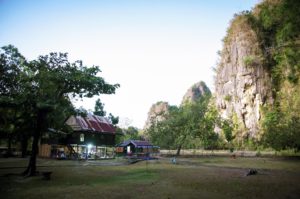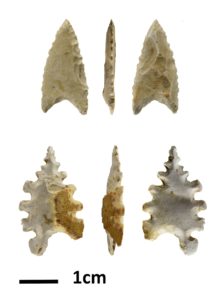
New research has questioned theories that a mysterious group of hunter-gatherers from Indonesia interacted with Aboriginal Australians thousands of years ago and provides a basis for future understanding of the people who made tiny, but precise implements out of stone.

The study, published in PLOS ONE, was led by Griffith University researchers at the Australian Research Centre for Human Evolution and Indonesian counterparts from Pusat Penelitian Arkeologi Nasional (Puslit Arkenas), who examined a collection of stone and bone 'point' tools made by the Toalean people on the Indonesian island of Sulawesi.
According to the study's lead author, PhD candidate Yinika Perston, the Toaleans were a group of 'hunter-gatherer' people who lived in southernmost Sulawesi around 1500-8000 years ago. During this time, they produced several distinctive small tools that have not been found elsewhere on the island, including the so-called 'Maros points', which were possibly used as arrowheads and have fine tooth-like serrations. Sul
"Previously, these tools have been fairly inconsistently or even incorrectly described yet have been used to build elaborate scenarios for human activities," Perston said.
"In our paper, we provide the most complete technological description of Toalean stone and bone tools yet. We describe exactly how they were made and outline new classification models for the most distinctive forms of stone and bone tools produced in that time."

The 1739 tools were found in known Toalean sites in caves within the limestone karst that runs through Maros and Pangkep.
Among these, Perston and team reclassified the small Maros point tools (averaging 25mm long) as four different variants - the Maros point, Mallinrung point, Lompoa point and Pangkep point.
Working backwards to examine how the specialised tools were made, Perston looked closely at the marks or 'scars' where other pieces of stone had been removed and where these scars overlapped, to gain a clearer view of what order the pieces of stone were struck to make the tools, and how.
"There are theories that the points were used for arrowheads or for hunting fish, but we're hoping that the next stage of research would be to look at the residue on the tools so we can find traces of what the Toaleans might have been using them for," she said.
"We also described a new stone tool form, the 'sawlette', which are very similar to certain tool types from Europe, but this is clearly a case of cultural convergence" - that is, unrelated peoples independently coming up with broadly similar traits or solutions."

Perston said the study also laid the groundwork to assess archaeological scenarios that have been previously proposed, such as similarities between some of the tools in Australia and Sulawesi that implied that the two regions had contact and exchanged ideas thousands of years ago.
While not ruling out the possibility that ancient Aboriginal communities made contact with people outside Australia, the study indicates that the evidence for a connection to the Toaleans, at present, is not strong.
"We found that while Maros points from Sulawesi look similar to some Australian tools - for example, the famous Kimberley spearheads - the production processes for the Toalean points and Australian stone points are actually quite different, and this is a topic we hope can be explored further," Perston said.
"Furthermore, the 'backed microliths' and the 'bone points' that we find in Toalean assemblages are found in other sites around the world. Their presence in Australia might simply be due to convergence, as is the case with the Toalean sawlettes which clearly have no connection to Palaeolithic Europe.
"We hope this study will be an important tool for archaeologists in Sulawesi, so that future research can be more consistent and reliable."
The research 'A standardised classification scheme for the Mid-Holocene Toalean artefacts of South Sulawesi, Indonesia' has been published in PLOS ONE.






